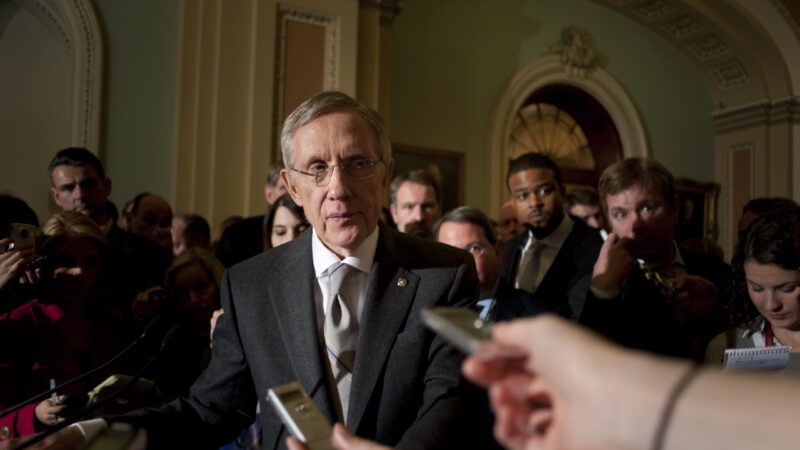How Harry Reid Broke the Senate
The Senate no longer debates or deliberates.

Former Sen. Harry Reid (D-Nev.) died on December 28 after recently being diagnosed with pancreatic cancer. He was 82 years old. Reid was one of the most influential Democratic politicians of the last four decades before retiring in 2016. He spent most of that time in the Senate, first winning a seat there in 1986. Reid led Senate Democrats for 12 years (from 2005 to 2016). He served as the Senate's majority leader for eight years (from 2007 to 2014). Only two other senators have served longer in that role: Sen. Mike Mansfield (D-Mont.) and Sen. Robert Byrd (D-W.Va.). And like Mansfield and Byrd, Reid had an outsized impact on the Senate—and not for the better.
Reid earned a reputation among his opponents as a scrappy partisan street fighter who would do anything to win. He routinely infuriated Republicans with deft parliamentary maneuvering and unapologetic rhetoric. Reid often worked closely with his counterpart, Sen. Mitch McConnell, (R-Ky.) to ensure that the Senate passed legislation that the two leaders, and a bipartisan mass of senators, supported over the objections of liberal Democrats and conservative Republicans. Yet Reid's leadership prowess also helped create the dysfunction that grips the Senate today.
And therein lies Reid's lasting, and tragic, legacy. He skillfully wielded the majority leader's limited powers to make the Senate work while, at the same time, creating the impression that it was bitterly divided between Democrats and Republicans. Reid simultaneously downplayed Democrats' policy disagreements and highlighted their differences with Republicans. And he ensured some bills still passed by setting the Senate's agenda, overseeing important negotiations with Republicans, and then structuring subsequent floor debates to make it harder for any senator, liberal or conservative, to alter or defeat the products of those negotiations.
Reid's skill as a leader allowed him to essentially eliminate genuine deliberation on the Senate floor while ensuring that the Senate still legislated, a balancing act that his successors have struggled to perform.
Reid's tenure as majority leader set the standard for what senators expect of their leaders. That is, before Reid, senators understood the majority leader's primary responsibility to be facilitating the participation of interested senators in floor debates and keeping the legislative trains running on time. After Reid, senators understand the majority leader's primary responsibility to be protecting senators from taking votes they want to avoid, crafting legislative compromises, and structuring the legislative process to ensure that the Senate approves them.
Reid's dramatic transformation of the majority leader's responsibilities is especially striking because senators did not create the position officially until the 1920s. Before then, Senate leadership was provided by senators of extraordinary ability (e.g., Sens. John C. Calhoun, Henry Clay, and Daniel Webster) or committee chairmen. And while the centralized role that today's Senate leaders play first emerged in the 1980s and 1990s, no majority leader before Reid was as intimately involved as he was in all aspects of the legislative process inside the Senate.
Reid's success in altering senators' expectations of the majority leader's responsibilities is even more striking because he led a Democratic Caucus that was beset with widening divisions over major issues like immigration, health care, and guns. As majority leader, Reid kept such party-fracturing issues from jeopardizing Democrats' ability to pass other bills by preventing senators from forcing floor votes on them. The result of Reid's efforts was to create the false impression that the Senate was bitterly divided between Democrats and Republicans when the reality was that there was considerable bipartisan agreement between senators on most issues.
Reid's leadership skill is evident in his creative use of the Senate's rules and practices to tightly control the floor and ensure that nothing happened there without his permission.
For example, Reid pioneered the now-ubiquitous tactic of filling the amendment tree and filing cloture on bills preemptively once the Senate began debating them. Filling the amendment tree blocks opponents of the bill from offering alternative proposals and protects its supporters from having to cast votes that could be used against them in their future efforts to win re-election. And filing cloture preemptively speeds Senate consideration of legislation and often confronts senators with a fait accompli, forcing them to choose between offering their amendments and passing the underlying bill.
Most controversially, Reid set the precedent for ignoring the Senate's rules when he could not use them to his advantage.
In 2013, Reid led his fellow Democrats to invoke the so-called nuclear option to effectively eliminate the filibuster for most presidential nominations. And McConnell and his fellow Republicans followed in Reid's footsteps by using the nuclear option to effectively eliminate the filibuster for Supreme Court nominations and to shorten the amount of time permitted under the rules after the Senate has invoked cloture on a nominee but before a final confirmation vote.
Reid's successors have struggled to imitate his example. They have successfully stifled deliberation on the Senate floor. But, unlike Reid, they have not figured out how to fashion bipartisan compromise on most controversial issues (e.g., not infrastructure). Consequently, today's Senate neither debates nor deliberates. We have Harry Reid to thank for that.
Show Comments (114)